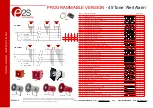
Installation and Service Manual
Precautions Against Corrosion
Using a Galvanic Isolator
Alternatively with AC shore supply, a galvanic isolator can be installed on the AC earth wire just after the
shore power inlet. This isolates the vessel from low voltage D.C. galvanic currents, while allowing any short
circuit to be safely conducted back to shore.
Recommendations:
Isolators with capacitors are preferred over isolators with diodes only.
An indicator or alarm that shows whether the earth current is being blocked. Since the isolator only
blocks low voltages (typically below 1.2V), higher voltages will pass through the isolator causing vessel
corrosion. This indicator will enable vessel operators to monitor any potential corrosion problems.
Must have sufficient fault capacity to allow circuit breakers to trip under fault conditions.
Isolators that comply with American Boat and Yacht Council recommendations (ABYC A-28, galvanic
isolators) will meet these requirements and are recommended by C.W.F.Hamilton Ltd.
A correctly wired polarization transformer in conjunction with a galvanic isolator is acceptable for
connecting to an AC shore power system.
Earth Bonding System
In aluminium and most G.R.P. hulls, the jet unit (if aluminium), all metal objects, electrical equipment casings
and hull anodes should be connected with a low resistance bonding system (separate from normally current
conducting 2 wire electric system).
The bonding strip and connecting wires should be aluminium or insulated copper of at least 14.5sq mm cross
section area (e.g. 5mm diameter) to give very low (e.g. 0.01Ohm) electrical resistance.
If a copper bonding strip is used, it should not be connected directly to the jet unit, as galvanic corrosion will
occur. The copper bonding strip should be connected to the jet unit via a stainless steel terminal connector.
The bonding wire or strip which runs the length of the hull should be kept clear of bilge water.
The main function of the bonding system is to provide a path to battery negative, for stray currents.
An exception exists for steel and G.R.P. hulls whose reinforcement is carbon fibre, the jet unit must be totally
insulated from the hull and machinery thus relying totally on its own anodes for protection.
When a bonding system is used, it is essential that cathodic protection is provided. This cathodic protection
can be in the form of sacrificial anodes or an impressed current system.
To minimise corrosion from stray currents emanating from within the vessel, all power sources (battery and
battery charger negatives, AC generator and the ship side of the shore supply earth) should be connected to
the earth bonding system at a single common earth point. This will hold these circuits at a common voltage.
Any stray currents will then have a direct path back to the battery negative or the AC source.
Alternatively, this connection to the battery negative can be deleted, provided that the following are carried
out:
There is a two wire normally current conducting electrical system which is isolated from the hull, jet unit
and engine.
There is an effective leakage monitoring system, such as the "test light" system, which is used regularly
and the results are recorded.
Without the bonding system to battery negative connection, stray current corrosion is possible and it is
important to check for leakage:
For every item of electrical equipment in operation.
When there is any alteration to the electrical system of the boat.
When any electrical connection is made to shore.
4-3
Содержание HJ212
Страница 1: ...HJ212 Installation and Service Manual R3A3 Jet unit Manual ...
Страница 20: ...Product Description Installation and Service Manual 2 6 ...
Страница 56: ...Commissioning Installation and Service Manual 6 4 ...
Страница 62: ...Fault Finding Installation and Service Manual 7 6 ...
Страница 82: ...Maintenance Installation and Service Manual 8 20 ...
Страница 137: ...Installation and Service Manual Appendix Notes 10 21 ...
Страница 141: ...Installation and Service Manual Appendix Notes 10 25 ...
Страница 164: ...Appendix Installation and Service Manual 10 48 ...
Страница 166: ......
Страница 169: ......
Страница 171: ......
Страница 172: ......
Страница 174: ...5 4 13 5 4 1307 0 3 453 5 4 4 4 05 50 64 8 53 5 50 5 5 3 454 0 8 50 0 5 54 3 5 0 5 8 50 0 5 11307 4 P 4 3 8 5 ...
Страница 175: ......
Страница 176: ......
Страница 177: ......
Страница 178: ......
Страница 181: ......
Страница 185: ......
Страница 186: ......
Страница 188: ......
Страница 195: ......
Страница 196: ......
Страница 197: ...Notes ...
















































